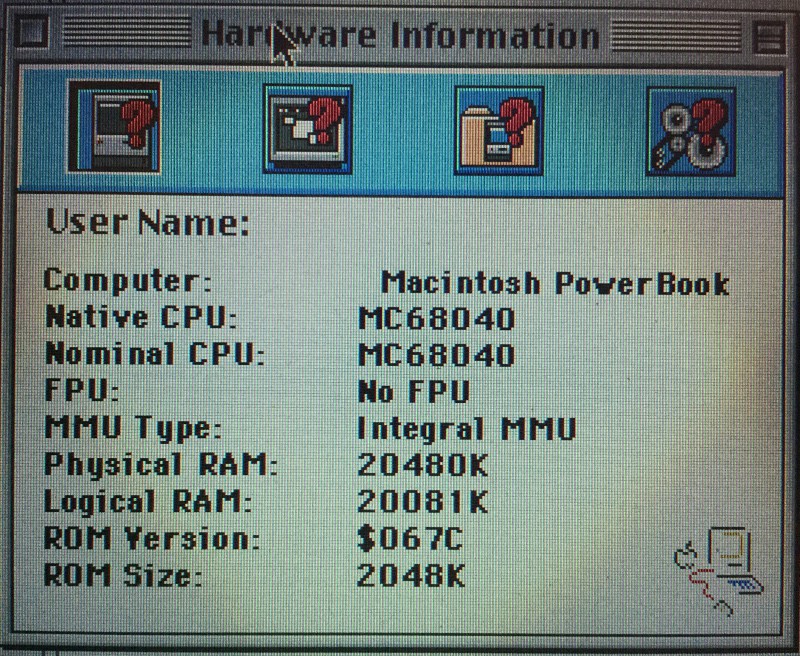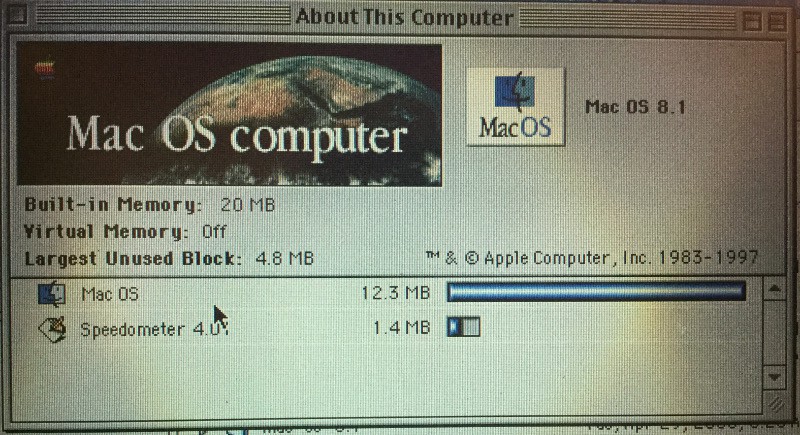Well, that's the end of that. My 68040 is most definitely a fake. Looks like they took a 68LC040, took off the markings, and printed or lasered on fake ones.
--- NONONONO! ---
MC68040EC33V does not contain an FPU, despite no 'LC' designation! Arrgh!!!
http://www.cpu-world.com/CPUs/68040/Motorola-MC68040FE33V.html
I've got the laptop to Mac OS 8.1, which does not use hardware-specific system enablers, and the diagnostic is still showing no FPU present.


So, what was learned?
1. You can desolder a dense QFP nicely with ChipQuik and a regular soldering iron.
2. You can solder a dense QFP back on with a regular soldering iron and solder wick, but a Mantis scope helps immensely.
3. OSX 10.5.6 won't mount an AppleShare volume from MacOS and vice-versa, but both will work with netatalk 2.x. I think OSX 10.4 was the latest that would work.
4. OSX 10.5.6 won't mount a disk formatted under System 7, and neither will System 7 mount a volume formatted as 'standard' under 10.5.6. Must be an HFS vs. HFS+ issue.
5. macintoshgarden.org is your friend when it comes to getting old versions of MacOS
Otherwise, the question has been settled: yes you can upgrade a Powerbook 500-series to a 68040 yourself, IF you can find a real chip to do it with!
ADDENDUM
It turns out the MC68040FE33V does not have an FPU! The 'V' denotes 3.3v but apparently also no FPU!
 hackaday
hackaday
Discussions
Become a Hackaday.io Member
Create an account to leave a comment. Already have an account? Log In.
Mac OS 7.5 incorporated all the enablers that had been used by prior Mac OS or System versions for all Macintosh models up to the 7.5 release, which were capable of running 7.5. New enablers were required for Macs released after 7.5, but those were replaced with the 7.5.1, 7.5.3 and 7.5.5 updates. 7.5.2 was buggy and quickly pulled.
http://www.yale.edu/acsca/macguide/System/System.Folder.html#enablers
Are you sure? yes | no
So by 8.1 it should have support for all the 500-series, including the 550c. This, to me, reinforces the conclusion that I have a relabled 68LC040.
Are you sure? yes | no
Would you be willing to desolder the 68040 from a desktop motherboard? That processor was used on the Quadra 610, 630, 650, and 660. Yes, I'm suggesting butchering an antique Mac - I think I have some old ones in my parents' attic. I can ask for the model numbers just to be sure.
Are you sure? yes | no
I believe all the 68040/68LC040 desktop models used a socketed CPU. This would be a PGA-style chip vs QFP-style used in the laptop. Also, it would be 5v vs 3.3v.
Let me know what you find in the attic, though. If you post it on https://www.reddit.com/r/VintageApple/ I'll see it.
Also, I was searching aliexpress recently and found a few vendors which claimed to have MC68040FE33V or MC68040FE25V, so all hope is not lost. If I find some, I'll see if I can get a sealed factory tray of them, which will hopefully reduce the chance of fakes and also reduce the chance of bent pins. It really wastes a lot of time straightening the tiny QFP pins vs getting a nice new part which can go straight to the board without any issues.
Are you sure? yes | no
Back in the old versions of Mac OS they did look at the machine 'gestalt' and from there give you the appropriate 'system enabler'. So, for System 7, if you had a 550c, which did have a full 68040, you would have a different enabler. However, that supposedly went away at System 8.
I looked at the Freescale docs for the 68040 (http://www.nxp.com/files/32bit/doc/ref_manual/MC68040UM.pdf) and basically, you know you're dealing with a 68LC040 when the CPU throws an exception when you try to run the missing instructions/registers. So, it's not like there's a missing or not connected pin or something on an LC version of the CPU.
I've done CPU swaps on 68K Mac before, and generally they just work. Granted, it's a whole lot easier to do on a desktop where the CPU is socketed.
Somewhere on a warehouse shelf are trays and trays of the legit part. Just not on ebay at the moment.
Are you sure? yes | no
As someone who's never tried to replace a Mac's CPU:
I'm no expert, but if Apple had "Enablers" and checked gestalts in <8, then what's to say they don't have the exact same concept in >=8, except embedded in the system file(s) rather than in extension-files...? Kinda like linux can compile certain bits as modules, OR those modules *can* be embedded in the kernel itself. And... if it was Apple's *intention* to get rid of enablers in later OS's, and the *need for* enablers on later *hardware*, BUT they'd been using them in prior OS's, then it seems somewhat reasonable to assume that that technique of system-identification *might* still be necessary for older hardware running the newer OS's.Are you sure? yes | no
According to this
http://www.rgaros.nl/gestalt/chapters/ch-06.html the whole 500-series used the same gestalt of 72, so I guess it's actually a check for exception with regards to the FPU.
Are you sure? yes | no
6. weird. Bummer, yo!
Are you sure the OS doesn't have some sort of lookup table for the system-specs...? You know how Apple likes to keep their systems tight, detecting model-numbers and whatnot... Or maybe a firmware thing...?
Are you sure? yes | no
or just write a small program that use FP opcodes and see if it traps ?
Are you sure? yes | no